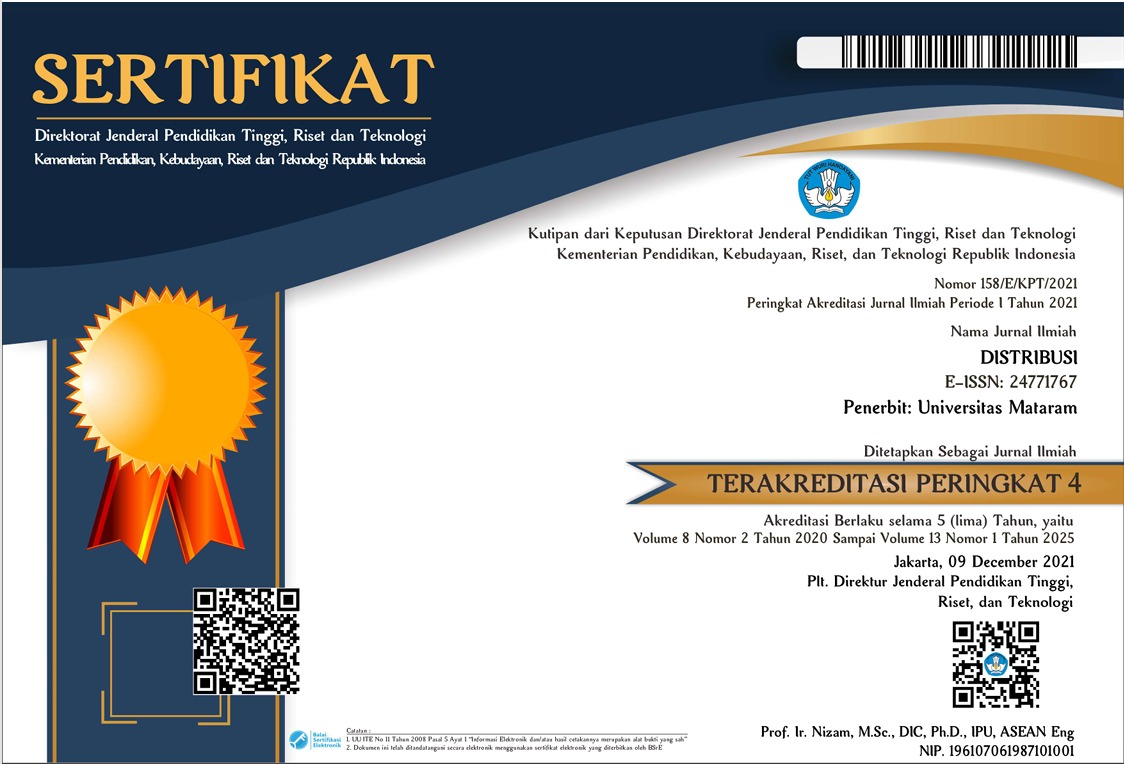PENILAIAN KINERJA PORTOFOLIO BERDASARKAN KALKULASI IMBAL HASIL DENGAN METODE TIME WEIGHTED RETURN (TWR) DAN DOLLAR WEIGHTED RETURN (DWR) PADA KELOMPOK INDEKS TEMATIK
DOI:
https://doi.org/10.29303/distribusi.v10i1.210Keywords:
Selected:Portfolio Performance, Stock Indices, YieldsAbstract
This study aims to assess portfolio performance using two methods, namely the time weighted return method and the dollar weighted return method. The portfolio is formed on the BUMN 20 index which shows an indication that maximum returns can be obtained. This research method is carried out by forming a portfolio based on the IDX BUMN 20 factsheet data, from 10 constituents included in the IDX BUMN 20. Furthermore, the TWR calculation is carried out using the arithmetic average and DWR calculations using the XIRR formulation in ms. excel. The analytical tool used to test the significance of differences in performance calculations is an independent t-test which is run using Minitab 14. The results of this study indicate that portfolio performance using the TWR calculation appears to be higher than the DWR calculation. The TWR calculation ignores the possibility of adding funds to the investment, in contrast to the DWR calculation which calculates the possibility of additional reinvestment. TWR is based on buy and hold assumptions only. Therefore, referring to the test results, it can be suggested that the investment that should be made by investors is to follow the buy and hold mechanism, although this study ignores other factors such as investor preferences in investing, so that it can be a development for further research.
Downloads
References
Alteza, M. (2010). Diktat Manajemen Investasi. Yogyakarta: Universitas Negeri Yogyakarta.
Brinson, G. P., Hood, L. R., & Beebower, G. L. (1986). Determinants of Portfolio Performance. Financial Analysts Journal, 39-44.
Brinson, G. P., Singer, B. D., & Beebower, G. L. (1991). Determinants of Portfolio II: An Update. Financial Analysts Journal, 40-48.
Bursa Efek Indonesia. (2019). Buku Indeks 2019. Jakarta: Bursa Efek Indonesia.
Dani Puspita, N. P., & Purnawati, N. (2019). Kinerja Portofolio Saham Berdasarkan Ukuran Perusahaan. E-Jurnal Manajemen, 7196-7215.
Dichev, I. D. (2004). What are stock investors' actual historical returns? Evidence from Dollar-weighted Returns. Michigan: Stephen M. Ross School of Business, University of Michigan.
Hermawan, W., & Tjendrasa, K. (2020). Evaluation of Investment in IoT Startup at PT. TMI. JISORA: Jurnal Ilmu Sosial, Politik & Humaniora, 22-31.
Hood, L. R. (2005). Determinants of Portfolio Performance-20 Years Later. Financial Analysts journal, 6-8.
Jandiar, M. D. (2008). Pengukuran Imbal Hasil Investor dengan Metode Dollar-Weighted Return pada Saham-saham JII 2003-2007. Jakarta: Universitas Indonesia.
Rudiyanto. (2014, Juli 24). Rudiyanto Berbagi Tentang Perencanaan Keuangan dan Investasi. Retrieved from rudiyanto.blog.kontan.co.id: http://rudiyanto.blog.kontan.co.id/2014/07/24/mengenal-time-weighted-return-dan-money-weighted-return/
Zweig, J. (2002, June 1). CNN Money. Retrieved from CNN Business: https://money.cnn.com/magazines/moneymag/moneymag_archive/2002/06/01/323312/index.htm
Downloads
Published
How to Cite
Issue
Section
License
Copyright (c) 2022 Baiq Nurul Suryawati, Zainal Abidin, Muttaqillah

This work is licensed under a Creative Commons Attribution-ShareAlike 4.0 International License.
Penulis yang naskahnya diterbitkan menyetujui ketentuan sebagai berikut:
- Hak publikasi atas semua materi naskah jurnal yang diterbitkan/dipublikasikan dalam situs Jurnal DISTRIBUSI ini dipegang oleh dewan redaksi dengan sepengetahuan penulis (hak moral tetap milik penulis naskah).
- Ketentuan legal formal untuk akses artikel digital jurnal elektronik ini tunduk pada ketentuan lisensi Creative Commons Attribution-ShareAlike (CC BY-SA), yang berarti Jurnal DISTRIBUSI berhak menyimpan, mengalih media/format-kan, mengelola dalam bentuk pangkalan data (database), merawat, dan mempublikasikan artikel tanpa meminta izin dari Penulis selama tetap mencantumkan nama Penulis sebagai pemilik Hak Cipta.
- Naskah yang diterbitkan/dipublikasikan secara cetak dan elektronik bersifat open access untuk tujuan pendidikan, penelitian, dan perpustakaan. Selain tujuan tersebut, dewan redaksi tidak bertanggung jawab atas pelanggaran terhadap hukum hak cipta.









